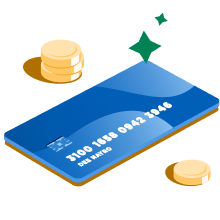SBA Loan Down Payment: How Much Do You Need?

Many or all of the products featured here are from our partners who compensate us. This influences which products we write about and where and how the product appears on a page. However, this does not influence our evaluations. Our opinions are our own. Here is a list of our partners and here's how we make money.
SBA loan down payment requirements vary based on the loan program, lender and your qualifications. Many SBA lenders require you to provide a down payment of at least 10% of the loan amount.
Lenders often require you to put money down upfront because it shows you have an investment in paying the loan back, thereby reducing their risk of working with your business. Even if you don’t need to provide a down payment, doing so can help you access an SBA loan with more competitive interest rates and repayment terms.
How much do you need?
We’ll start with a brief questionnaire to better understand the unique needs of your business.
Once we uncover your personalized matches, our team will consult you on the process moving forward.
An SBA loan down payment is sometimes referred to as an equity injection. The U.S. Small Business Administration often uses the term equity injection instead of down payment in its official documentation.
SBA loan down payment requirements by loan type
SBA loan type | Maximum loan amount | Down payment |
|---|---|---|
7(a) loans | Up to $5 million. | 10% or more. |
CDC/504 loans | Up to $5 million (up to $5.5 million for select projects). | 10% to 20%. |
Microloans | Up to $50,000. | None. |
Disaster loans | Up to $2 million. | None. |
How much do you need?
We’ll start with a brief questionnaire to better understand the unique needs of your business.
Once we uncover your personalized matches, our team will consult you on the process moving forward.
SBA 7(a) loan down payment
SBA 7(a) loans can be used for working capital, debt refinancing, business acquisitions and purchases of equipment, real estate or inventory. These loans have interest rates that range from 11.5% to 15% and repayment terms of up to 25 years.
Down payment requirements vary based on the type of 7(a) loan:
Standard 7(a) loans
The SBA requires a down payment for standard 7(a) loans (loans greater than $500,000) in cases of a complete change of ownership. In other words, if you use your 7(a) loan to buy a business, the SBA will require you to provide a down payment of at least 10% of the total project costs.
In all other cases, lenders’ down payment policies for 7(a) loans must be consistent with their requirements for similarly sized, non-SBA business loans. This means, if a bank typically requires a 20% down payment for a $750,000 business loan, it should require the same 20% down payment for a $750,000 7(a) loan.
7(a) small loans and Express loans
For 7(a) small loans and SBA Express loans, down payment requirements are completely at the lender’s discretion. Based on their own judgment and underwriting criteria, these lenders can decide whether or require you to provide a down payment — and how much is needed.
Although 7(a) small loans and Express loans both have a maximum loan amount of $500,000, Express loans are administered by Express-authorized lenders, who have the ability to expedite the SBA loan application process.
» MORE: How to apply for an SBA loan
CAPLines
The SBA CAPLines program, a subcategory of 7(a) loans, offers lines of credit to small businesses to meet their cyclical or short-term working capital needs. These SBA lines of credit are available in amounts up to $5 million.
CAPLines have similar down payment requirements to standard 7(a) loans. Lenders should ask for a down payment if they require one for comparable non-SBA commercial lines of credit.
How much do you need?
We’ll start with a brief questionnaire to better understand the unique needs of your business.
Once we uncover your personalized matches, our team will consult you on the process moving forward.
SBA 504 loan down payment
SBA 504 loans, or CDC/504 loans, are specifically designed for the purchase, renovation or building of commercial real estate — as well as the purchase of equipment and machinery. Loan amounts are typically available up to $5 million, but certain public energy projects and small manufacturers can qualify for up to $5.5 million.
SBA 504 loans are structured to require a minimum down payment of 10% from the borrower. These loans come from three sources:
A third-party lender: 50%.
A Certified Development Company (CDC): 40%.
The borrower: 10%.
This is the standard 504 loan structure, in which you’re required to provide a total of 10% of the loan amount. In certain instances, however, you’ll need to provide a larger down payment.
New business or limited/special use property: If you are a new business (in operation for less than two years) or you have a limited or special use property, you’ll need to provide a down payment of at least 15% of the loan amount. A limited or special use property is a property with “a unique physical design, special construction materials or a layout that restricts its utility to the use for which it was built.” Examples include bowling alleys, farms, gas stations, hotels and theaters.
New business AND limited/special use property: If you’re a new business and have a limited or special use property — e.g. your bowling alley has only been in operation for one year — you’ll be required to provide a down payment of at least 20% of the loan amount.
SBA loans with no down payment requirement
These SBA loan programs do not require a down payment. If you can provide a down payment (even when it’s not required) however, it may help you access better interest rates and repayment terms.
SBA microloans
The SBA microloan program is designed to provide funding to traditionally underserved businesses, including startups, women-owned companies and businesses located in low-income communities. Loans can be used for a variety of purposes and are available in amounts up to $50,000.
Unlike other SBA loan options, microloans are issued by participating intermediaries, such as nonprofit and community lenders. These organizations establish their own underwriting criteria, which are typically more flexible than traditional SBA loan requirements.
Generally, you’ll need to provide collateral to qualify for an SBA microloan, but it’s less likely that you’ll need to put up a down payment.
SBA disaster loans
SBA disaster loans can be used to help businesses recover from a declared disaster or the loss of a crucial employee. The SBA offers three types of disaster loans for businesses: Business physical disaster loans, economic injury disaster loans and military reservists economic injury disaster loans (MREIDL).
These loans are available in amounts up to $2 million with repayment terms up to 30 years. To qualify for an SBA disaster loan, you’ll need to show your ability to repay the financing — through your personal credit, personal finances and business finances — but a down payment isn’t required.
For loans of more than $25,000, however, you will be required to provide collateral.
How to get a down payment for an SBA loan
You can fund your SBA loan down payment in a variety of ways:
Personal savings. If you have enough money in your personal savings, you might dip into this account to cover the cost of your down payment.
Personal loan. You might work with your personal bank to get financing to pay for your SBA loan down payment. In this instance, you’ll want to make sure that you can manage these loan payments — and that you aren’t putting your personal credit at risk.
Business partners or investors. If you work with a business partner, you might collaborate your efforts to afford the down payment — or turn to an investor for assistance. Keep in mind that investors will likely require some type of equity or stake in your company in exchange for the funding.
Business assets. You may own valuable assets that can be sold to cover down payment costs — provided you no longer need them to operate your business.
Rollovers as Business Startups (ROBS): In a ROBS transaction, you can move money from your retirement account, like a 401(k), into your business. Although this type of funding can be used to cover down payment costs, we’d recommend exploring other options before tapping into your retirement funds.
A version of this article originally appeared on Fundera, a subsidiary of NerdWallet.



